August 14, 2015
It’s just after 8:30 am I step out of the Willy Wallace hostel and set off on foot for the Battle of Bannockburn Visitor’s Centre, which is just over 2 miles away in nearby St. Ninian’s.
Stirling is quiet and still this Friday morning. The grey clouds and cool weather are keeping adventuresome tourists indoors, but the roads are busy with people on their way to work.
Just before I leave old town Stirling, I pass Mr. Simms Olde Sweet Shoppe, Purveyor of Finest Confectionery.
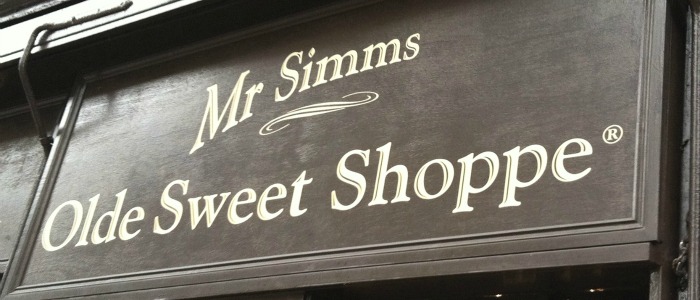
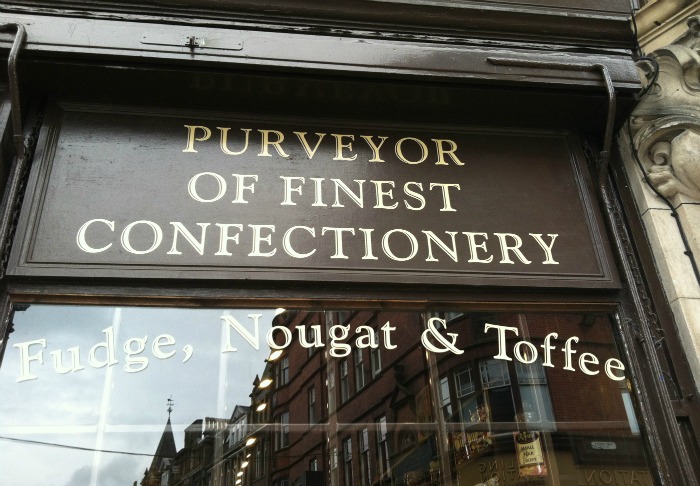
Luckily for me, Mr. Simms’ isn’t open.
On the way to Bannockburn, I pass a cute gatehouse . . .
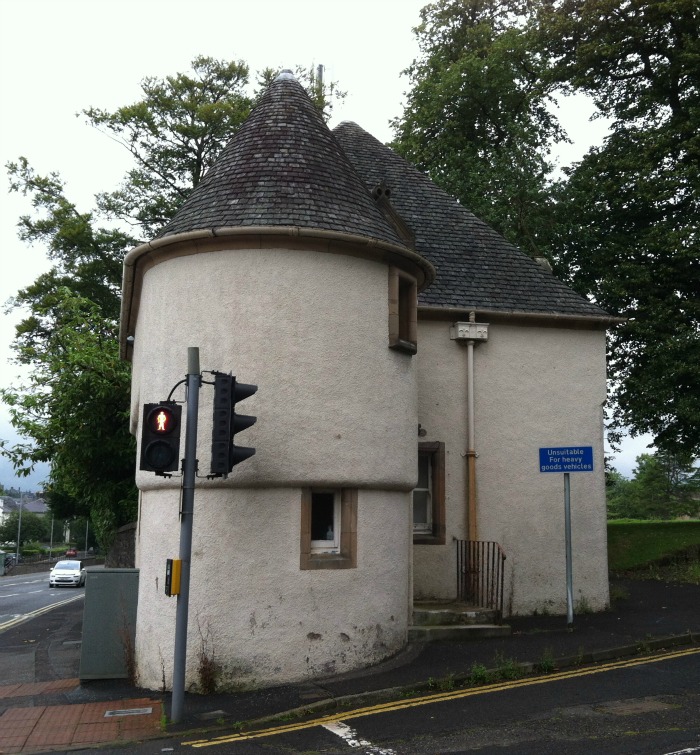
Rows of stately town houses . . .
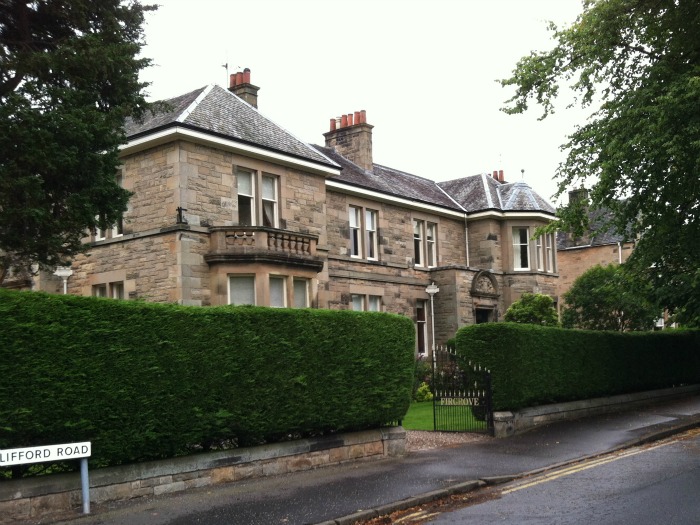
A strange climbing feature at the local park . . .
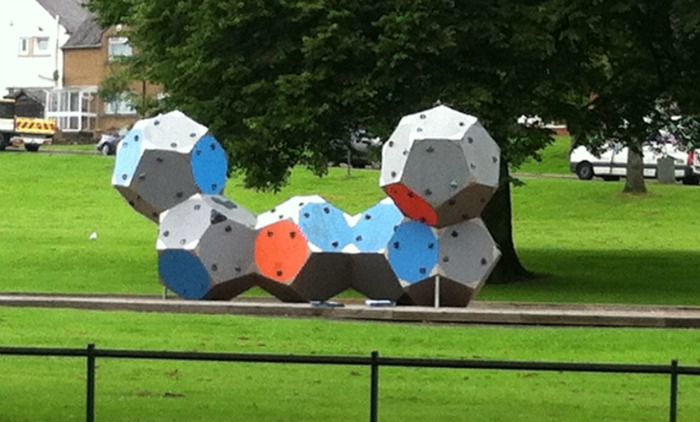
And lots of roses heavy with raindrops.
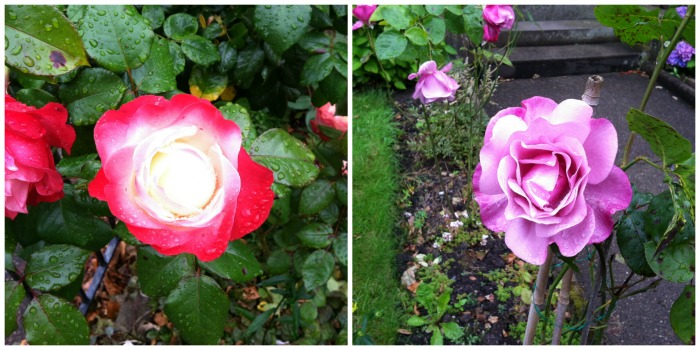
An hour after leaving my hostel, I arrive at the Battle of Bannockburn Visitor’s Centre. It’s not much to look at from the outside: a small square grey building with a promenade leading up to a nondescript monument.
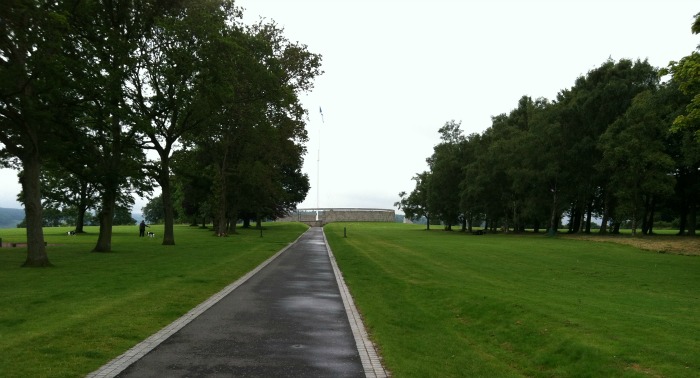
A plaque on the flagpole explains that this is the place where Robert the Bruce, King of Scots, raised his standard and made camp the night before the Battle of Bannockburn.
King Robert himself keeps watch over the monument in the form of a nearby statue.
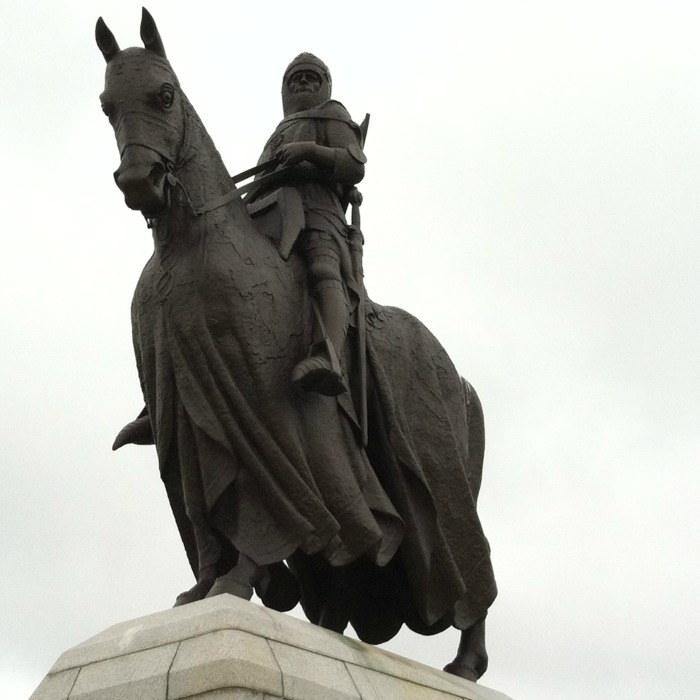
Looking up into Robert’s stern face, it’s easy to see why this statue is the most famous Robert the Bruce statue. There’s a sense of power about Robert, a sense of gravitas and purpose and steely determination.
It may just be the sculptor’s interpretation of Robert, but given what he went through to get to Bannockburn, I suspect that sculptor has captured the essence of Robert. He would have needed every once of power and self-confidence to kick the English out of Scotland.
By the time Robert arrives in Bannockburn in 1314, he’s been King of Scots for 8 years, and fighting the English every step of the way. In fact, England and Scotland have been fighting off and on for nearly 30 years, ever since King Alexander of Scotland died in 1286 without leaving behind any living children. His only grandchild, a three-year old girl named Margaret, died a few months after him. To prevent a civil war, the Scottish nobles asked King Edward I of England to decide which house had the best claim to the throne: the Balliols or the Bruces.
King Edward I decided in favor of John Balliol, figuring that he could use John to make Scotland part of England. After about 6 years in Scotland, John Balliol says “To hell with this, I’ve had enough” and goes off to France. Edward then invades Scotland, and spends the last years of his life trying to integrate Scotland into England.
All this sets the stage for Robert the Bruce, who inherits his grandfather’s claim to the throne around 1300. In 1306, he murders John Balliol’s heir, and declares himself King of the Scots. He’s excommunicated for the murder, but that doesn’t stop him from raising an army to push the English out of Scotland.
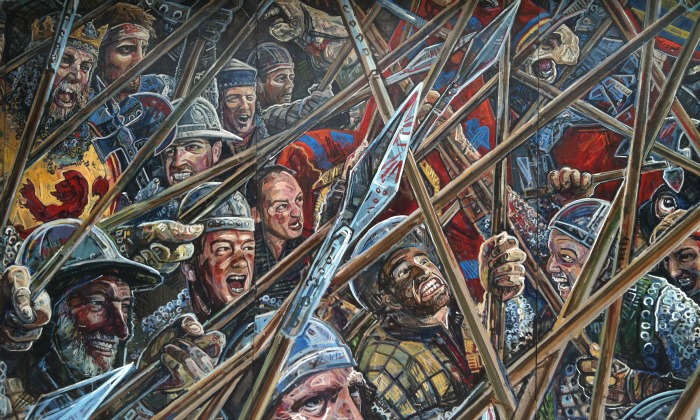
After nearly a decade of fighting, by 1314 Robert the Bruce is in control of most of Scotland. Stirling Castle is the only major castle left in English hands, and so he sends his only surviving brother to Stirling with orders to take the castle.
However, his brother makes a deal with the English commander: if the fort isn’t relieved by mid-summer 1314, the English commander will surrender the castle to the Scots.
So far, Edward II of England has stayed well away from the fighting in Scotland. But even he can’t ignore the challenge of relieving Stirling Castle. He marches an army north to Scotland, and stops a couple of miles south of Stirling Castle, near a stream called the Bannockburn. Meanwhile, Robert the Bruce has gathered together all of his fighting troops, and has arrived at nearby St. Ninian’s before the English.
All of this history is encapsulated in the statue of Robert looking out over the battlefields, which are quite peaceful on this grey August morning. Now that I’ve “met” Robert and surveyed the terrain, it’s time to head inside to the visitor’s centre.
Based on the visitor centre’s website, I have purchased a ticket for the 3D Battle Experience in advance. However, I’m not quite sure what that entails. The promo video on their website is intriguing but vague:
My ticket for the 3D Battle Experience isn’t valid for another 45 minutes, so I happily poke about the small gift shop, coming away with several postcards and two interesting books.
At 11:00 am, I’m given a set of 3D glasses and directed into a small theatre where 3D characters explain the lead-up to the battle, who the major characters are, and why they’re fighting.
Next, I’m let into a dark, triangle-shaped exhibit hall. The Vs of the triangle have screens showing live re-enactments of the battle, taken last year at the 700th anniversary celebrations. I fight the urge to duck as an arrow whizzes past my ear. It’s not really there, but the surround sound is so well done that it sounds as though I’m really in the middle of a battle.
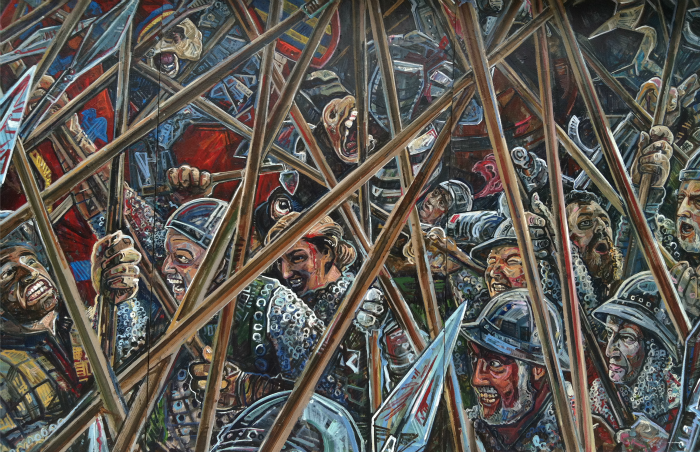
Between the screens are display stands with replica pieces of chain mail armor, maces, gauntlets, pikes, and longbows. I touch the cool shaft of a 15-foot pike as a cavalry charge begins on the screen opposite me. The darkened room, arrows whizzing, cavalry charging, men fighting, and the touch of weapons under my hands makes the battle suddenly real.
At the appointed time, our group is let into another theatre at the cross-bar of the triangle room. Acting on advice from the hostel concierge, I make sure I’m one of the last people to enter the battle room.
In front of us is a waist-high terrain map of the battlefield and surrounding area. The map is a good 8 feet across, and circular. We’re directed to stand on specific spots on the floor around the map. There’s a gallery behind us, for those group members who want to watch but not play.
Amy, our game master, then explains exactly what this 3D Battle Experience is all about. There’s a number under our feat for each of the spots around the table. These numbers dictate which side you’re on, and which unit or units you’ve been assigned in the battle simulation. Nearly 2/3 of our group are assigned to the English side, but to my delight I find myself on the Scottish side of the map.
Each side has a king (dictated by the numbered spot on the floor) and we’re given 4 turns to win the battle. All the English have to do is get their king and one foot unit to the castle. All we Scots have to do is stop that from happening.
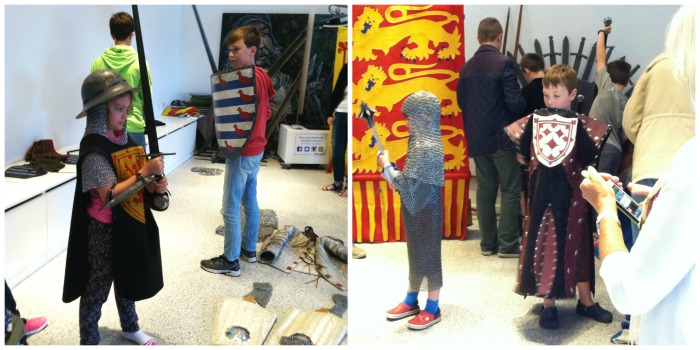
The first couple of turns are slow going, as it takes our group a while to figure out what all the units are, and where they’re supposed to go. At first there’s almost no communication between people on the same side, but by round 3 we’re working together to plan our attack or bolster units currently under attack.
Amy, our battle master, is incredible. There are a good 40 units on the map, displayed via digital logos on the terrain, and she knows what type of unit they are, where they came from, and where the other units are on the map. She uses her pointer to help us remember what’s going on and where, and she uses a control panel to move units based on what we tell her.
Finally, the English king makes a move towards the castle, and the Scots move to intercept him. We manage to kill the English king, which is an automatic win condition for the Scots. However, only Robert the Bruce is left alive on the Scottish side, with one-half of our single cavalry unit to support him.
There’s wild rejoicing among myself and my Scottish colleagues, and lots of laughter as both sides as we agree that it was a well-fought battle. More importantly, it gave us some idea of how badly out-numbered the Scots were, and how they had to use every bit of terrain to help them out.
The real battle, of course, wasn’t anything like our simulation. In the real battle, there was some fighting between the Scots and the English on 23rd June, but Robert the Bruce still wasn’t sure if he could take on the English army. During the night, a Scots deserter from the English side told Robert the Bruce that the English were demoralized, and that an early-morning attack would win the day for Robert.
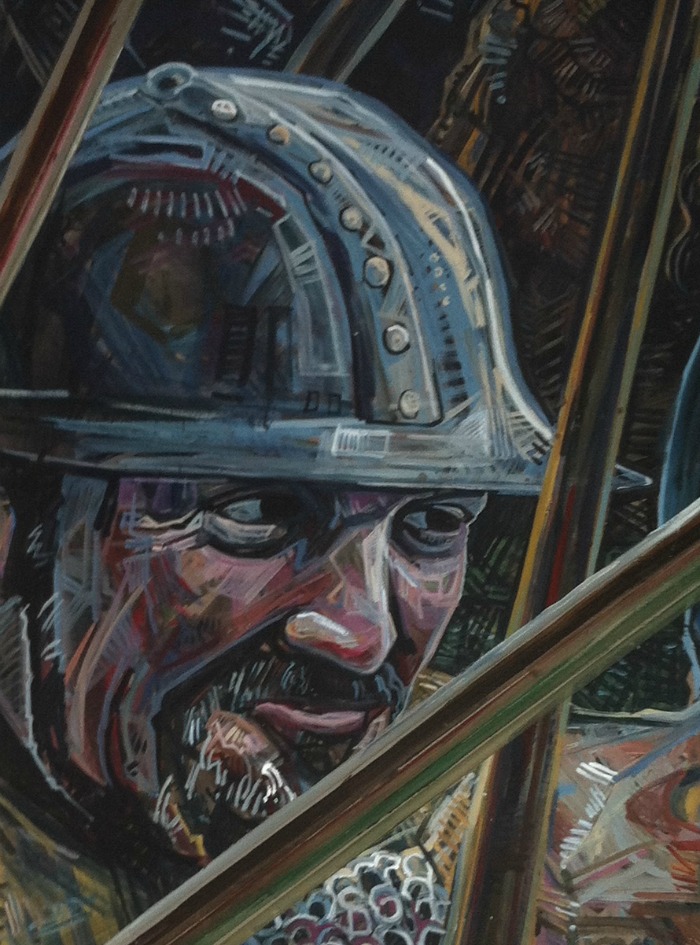
He must have decided to trust the deserter, because he attacked the English the next morning. The English were camped in a wet, boggy area that make camping – and maneuvering – pretty miserable. The Scots used their single cavalry unit to cut down the English longbowmen, while the main Scottish foot soldiers formed a series of schiltroms with long pikes to repel the English cavalry, who were the main shock and awe factor in the English army.
As the Scots kept advancing, the English tried to break and run. The English troops had nowhere to go except forward towards the Scots, or back across the Bannockburn. It is said that so many English drowned or were trampled to death in the Bannockburn that the Bannockburn ran red with blood.
As I leave the visitor’s centre, I see again the statue of Robert the Bruce outside near the monument.
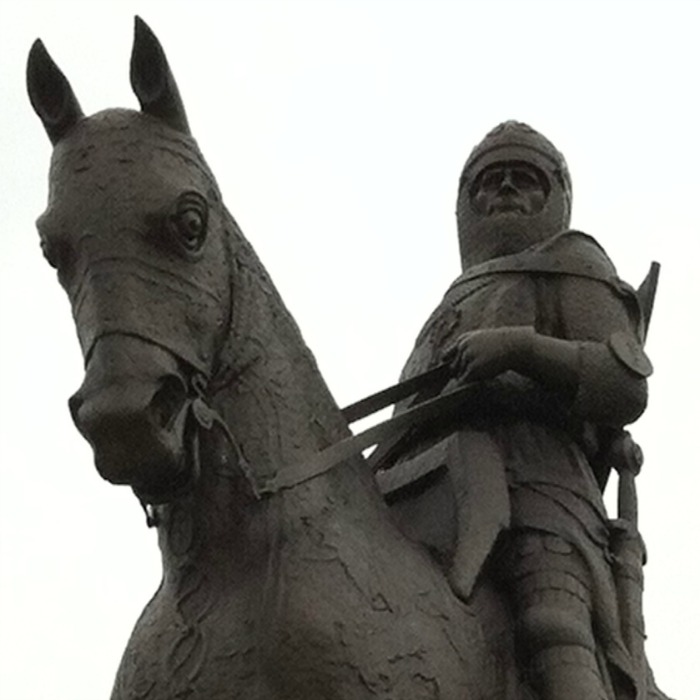
I can’t imagine how he must have felt as he watched Edward II retreat from the battlefield. Since becoming king, three of his four brothers had been hanged, drawn, and quartered by the English. His wife, daughter, and sisters were all captives in England, some of them forced to live in iron cages that were hung outside the castle walls in all weather.
For nearly 10 years, he’d fought viciously to regain every inch of Scottish territory under his control. Castle by castle, fort by fort, skirmish by skirmish, he’d worked to kick the English out of Scotland. And here, on the fields of the Bannockburn, he had decisively won his first pitched battle against a superior force.
I look around the fields of Bannockburn, trying to re-create the battle and its aftermath. Robert must have been hoping that a victory of this magnitude would finally push Edward II into giving up his claims in Scotland. It’s hard to imagine a different outcome, there on the battlefields with the Bannockburn literally choked with bodies.
And yet, Robert’s fight against the English continued for 13 years after his victory. Would he have set out to be king of Scotland if he knew the price would be continual fighting for 21 years? That all his brothers would be killed, and that he’d leave behind a 5-year old son to take up Scotland’s future?
No wonder his statute exudes fierce determination and purpose. King Robert the Bruce forever altered Scotland’s future, and her relationship with England. He spent a lifetime asserting Scotland’s claim as a nation independent of Britain, and lived to see his vision become reality.

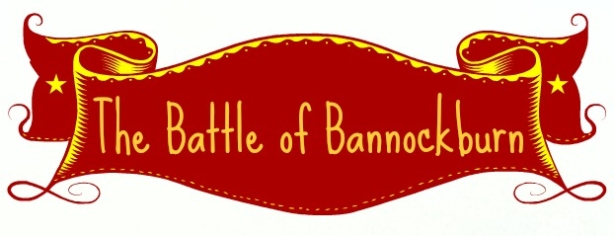









Memories that remain in the forefront of our minds after a visit are interesting — sometimes photographs prompt the “hidden” memories… No doubt the 3D battle scenario will stay with you for awhile.
I’d think that “de Brus” would have continued his fight even (or especially) if he’d known (his) future. He triumphed and had progeny — his name lived on, and there was enough “Gaelic” in him to make that significant.
(We) have difficulty “suspending our own belief” when looking back in time. Things like “family” and “nobility” had very different meanings. Robert was intent on supporting “King John” (Balliol) and (his) restoration but, after he killed John Comyn, his future path was more or less set. His (and his line’s) “destiny” was to conquer and rule all of Scotland — he could do no less…
Robert actually fought with Edward against Scotland before he decided to declare himself king. All the history books seem to agree, though, that once he killed John Comyn, he had no choice but to pursue the path that he took. It is hard to understand nowadays, but it must have been a great comfort to him to know that this was the only path forward.